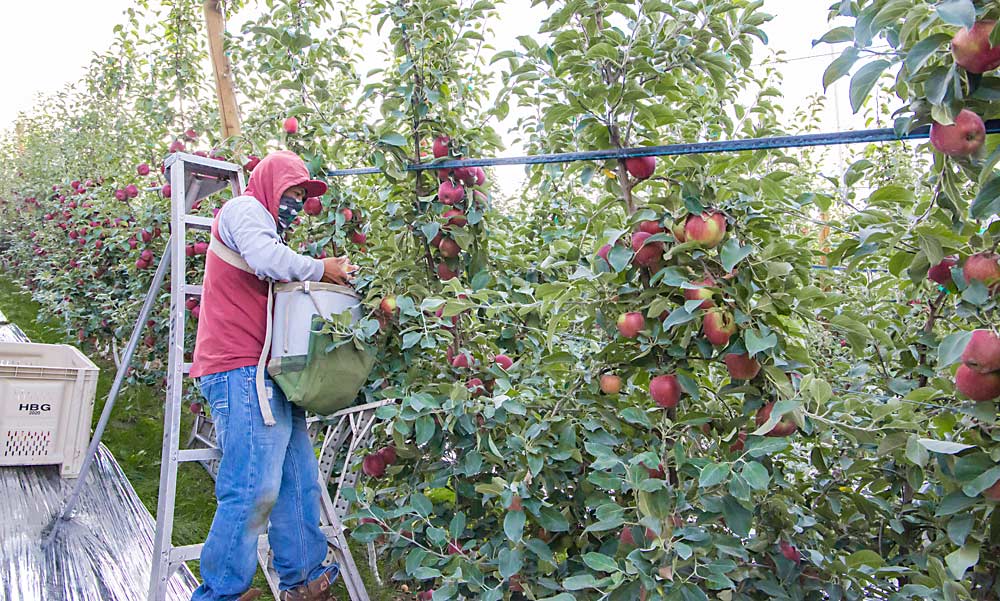
The WA 38 promised to be a one-pick apple, and it certainly is for some growers.
However, due to potential high returns and still young trees, some Washington producers elected to make more than one pass this year when harvesting the state’s newest apple, marketed as the Cosmic Crisp.
In early October, Oroville grower Dave Taber instructed his crews to selectively pick only apples hanging higher on the trees or on the outside of the canopy where more sun reached, as well as larger apples at risk of splitting. He also taught them to look through the red exterior coloring to the background color, choosing apples with a “breaking” color ranging from white through yellow. Apples with a lime green background were left hanging until his crews returned eight days later to finish.
He’s glad he did.
“To me, no question in the future, it’s a two-pick apple” in certain blocks, he said. He two-picked his block with a crop of 70 bins per acre, high on a hill overlooking Osoyoos Lake. His lighter crops, lower in the Okanogan Valley, he picked only once.
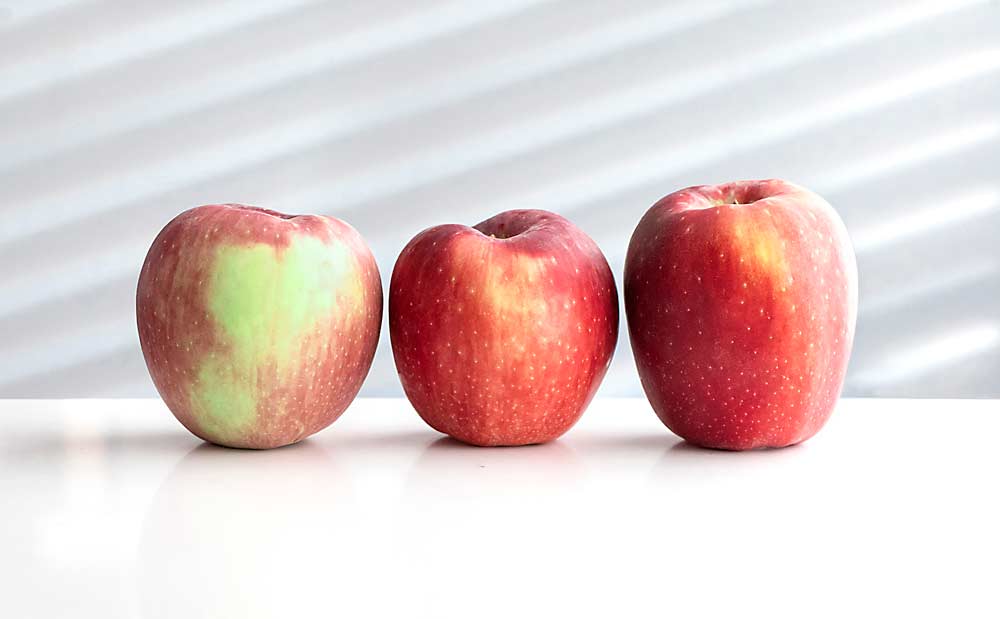
Though this was his first commercial WA 38 harvest, his workers are used to the exercise, he said. They have been color picking Honeycrisps for years, and WA 38s require fewer passes than Honeycrisps.
“Cosmics are still easier than Honeycrisps, by far,” he said.
In the Wapato area, grower Ric Valicoff pulled a crew of workers out of a Granny Smith block and moved them to a small WA 38 plot to color pick about 65 percent of the apples. He sent them back about nine days later to finish.
Valicoff said he could have gotten away with one pick, but he had the labor available and cooperative weather on the horizon. Last year, Valicoff one-picked his WA 38s to beat an October temperature dip into the mid-20s.
This year, waiting for the second pass boosted color by 15 percent to 20 percent, enough to bump the fruit from the second-tier Washington Fancy grade to top-grade Washington Extra Fancy. That could mean a price difference of $15 per box, he said.
“Right now, these things are very valuable,” he said.
Industry standards for Cosmic Crisp, marketed as a bi-colored apple, call for at least 50 percent red color with no hard green background for Extra Fancy and between 30 and 50 percent red for Fancy.
Taber and Valicoff both harvested after the apples reached 3 on the starch scale. Taber also harvested apples once they reached 4.5 on the scale, even if they lacked the correct background color, to avoid greasiness that more mature apples can develop during storage.
Still, some growers stuck with one pick.
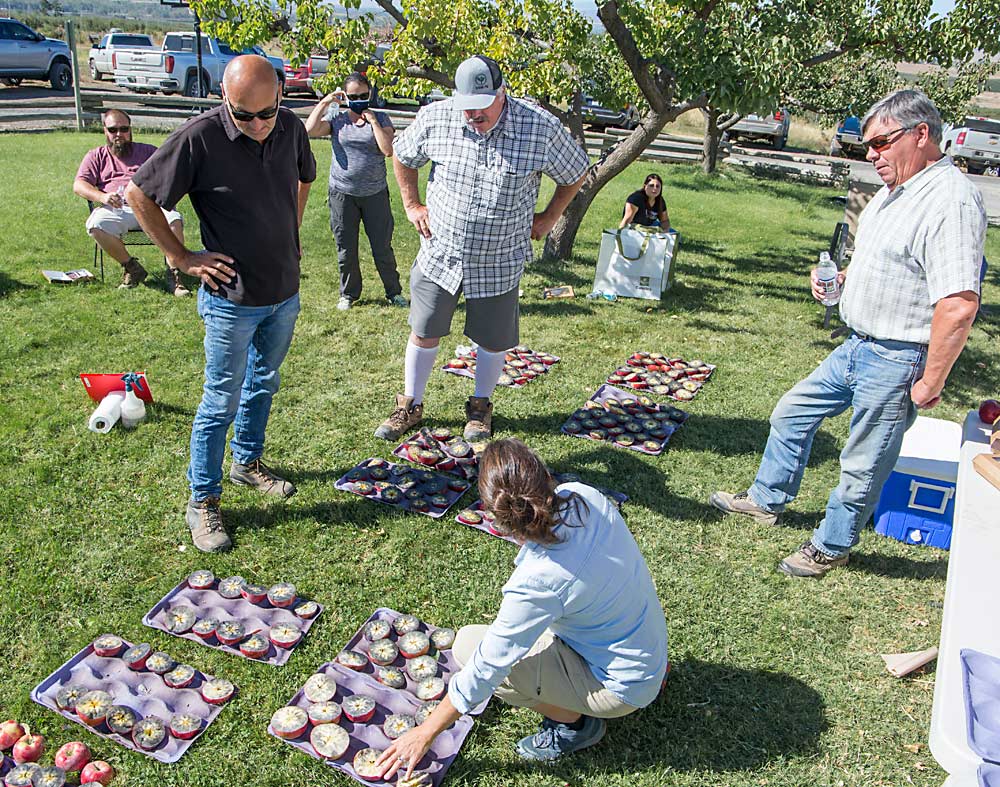
Dale Gasseling of White Swan picked all of his in one swipe. The growers working with Bob Groeneweg, a field representative with Legacy Fruit, did the same. All found their fruit colored well top to bottom, Groeneweg said. In late September, he was a little worried seeing undercolored fruit on the trees, but the apples rallied to mature evenly over the following five to seven days. “It was amazing,” he said.
Marty Robinson, orchard manager for Honeybear Growers of Brewster, said he wishes he would have two-picked. In hindsight, he chose to let apples hang a little too long, and many of them split, especially higher in the trees, he said.
But when trees are young and volumes are low, that is the time to experiment, he said. Last year, demand for the apples was so high he did not notice much difference between the price of Fancy and Extra Fancy. That may happen again this year.
But volumes are expected to rise rapidly, and he wants to be ready. In early August, growers estimated a harvest of 1.62 million boxes this year, but the industry expects 10.5 million boxes to reach the market in 2022.
“We need to learn where we’re going to be five years from now,” Robinson said.
One-picking should become more normal as trees get bigger, said Bernardita Sallato, extension specialist with Washington State University, which bred the apple.
Commercial WA 38 trees are still only in their third or fourth leaf this year. Young trees, pushed by growers to fill their space, have higher vigor and therefore more variability in fruit, Sallato said. But overall, the variety has a forgiving harvest window compared to others, she said.
“It can stay a long time on the tree without changing too much of the quality,” she said.
However, many apples, including the WA 38, may develop greasiness in storage if allowed to overripen. Growers must balance that with color and upcoming weather events when choosing their harvest schedule, Sallato said.
Canopy management will be important, she said. Balancing vigor throughout the tree will lead to more uniform fruit size, color and spacing.
She respects both decisions to one-pick or two-pick the apples, depending on the availability of labor and the cost-benefit balance for each grower.
However, she has one bit of universal advice: Remove fruit from the top of the leader while trees are growing in the first few years during orchard establishment. Cropping that part of the tree at that time could break fragile tops and prevent them from reaching the top wire, she said. •
—by Ross Courtney

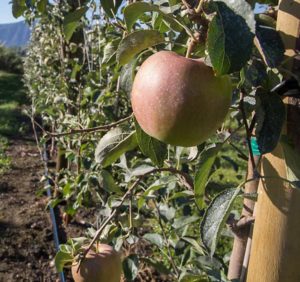
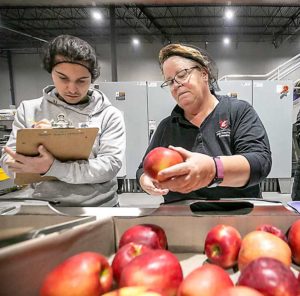
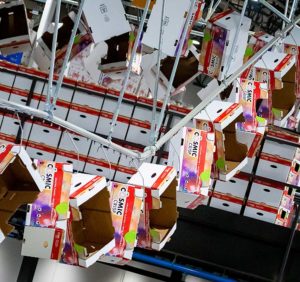





Leave A Comment